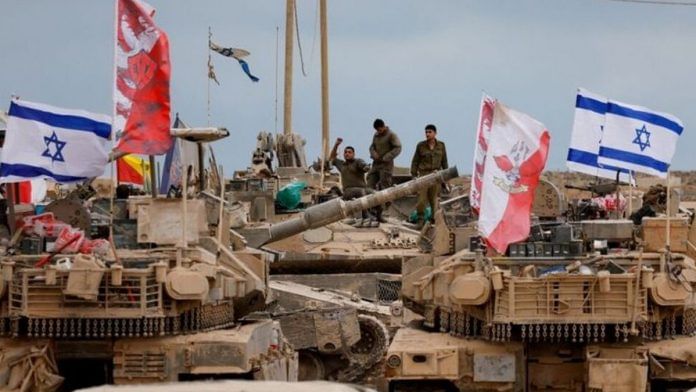Operation Swords of Iron, the grandiosely named war on Hamas and Gaza, is estimated to have cost a cumulative $100 billion, lasted over two years, and yet failed to achieve its stated military and political objectives.
The war levelled Gaza into rubble the likes of which has not been seen since the Anglo-American bombing of Dresden in February 1945. Under that rubble are as many as 14,000 bodies unlikely ever to be recovered or given burial as per custom, in addition to the more than 67,806 already confirmed killed. These numbers give some perspective on the scale of destruction sans quantifiable results.
Astronomical costs, little payoff
The $100 billion figure represents the combined expenditure of Israel, estimated to exceed $67 billion, and its principal benefactor, the United States of America, whose spending crossed $30 billion during this war. It also includes the various sideshows conducted over other countries such as Lebanon, Yemen, and Iran.
That is an extraordinary figure given the geography of the operational area, the technologies involved between the adversaries, the manpower deployed to secure results, and the ultimate outcome of the war. With numerous countries now declaring their recognition of the State of Palestine, and the United Nations Commission of Inquiry calling the war on Gaza genocide, the diplomatic costs for Israel far outweigh the $100 billion spent fighting an inconclusive war.
The casualty rates for Israeli security forces have been just as extraordinary, despite overwhelming manpower superiority, the limited terrain of operations, the vast technological advantages over the Hamas-led militant groups, and the continuous replenishment of war-fighting equipment provided by the US and other countries.
The official casualty figures released by the Netanyahu-led government show a total of 916 fatalities amongst the security forces and thousands injured. But what stands out in the roll call, and starkly at that, is the number of captains who have died in combat, a truly telling statistic.
In a Western-type force, which would logically be heavily dependent on non-commissioned officers, the number of captains killed in action suggests that these young officers had to lead combat operations in a continuous cycle, instead of letting NCOs conduct missions. Not that there is much age difference between young officers and NCOs in the Israeli army. The number of higher-ranking officers killed in action is also significant and could point to various factors—from sheer grit and a feel for action to being specifically targeted by Palestinian militants. Losing such a large number of commanders is truly uncommon.
This is especially so given the capabilities of the Hamas-led militants, who relied on smuggled weapons, some locally forged rifles, and other equipment, including rockets. US intelligence estimated the total strength of the Izz al-Din al-Qassam Brigades, the armed wing of Hamas, at between 20,000 and 30,000 combat-capable militants before hostilities began in October 2023. Given that they were operating in an area of just 365 square kilometres, against the most advanced military machine in this part of Asia, and continued to engage the Israeli army until the ceasefire, this is a feat rarely achieved by a militant group anywhere. And Hamas is still armed.
The total destruction of Hamas was the long-stated politico-military objective of Operation Swords of Iron, as repeatedly enunciated by Benjamin Netanyahu, the Israeli Prime Minister. Disarming Hamas, wiping them out, and other such formulations were the oft-repeated aims of the war.
Even when the option of a ceasefire and an exchange of hostages and prisoners was a distinct possibility from the first months of the conflict, the war was dragged on with the sole avowed aim of totally destroying Hamas. That hasn’t happened yet, and ultimately a negotiated ceasefire was accepted by both sides, with Hamas still standing.
Also Read: Trump and Hegseth’s speeches at military gathering show America fighting a war within
A precedent, and no lasting peace
After the longest war fought by Israel, which involved a truly sensational tonnage of bombs dropped on Gaza, including some of the most lethal US ordnance, a peace summit at Sharm el-Sheikh in Egypt sealed a ceasefire deal. Prisoners and remains were exchanged under full multinational guarantees. Many countries were present, and thankfully India attended as it should have.
But there is a precedent to such events in West Asia, and they tend to come to nought sooner rather than later. Nobel Peace Prizes were once shared, many handshakes exchanged, and a new era proclaimed under an American president — yet war followed.
Israel launched Operation Peace for Galilee in the summer of 1982, just a couple of years after sealing a peace deal with Egypt mediated on the lawn of Camp David by then US president Jimmy Carter. That was supposed to be the dawn of a new era, but death and destruction followed in Lebanon, with more than 600 Israeli soldiers losing their lives. That was an agreement signed between two neighbouring countries — Israel and Egypt — ignoring the very cause of disquiet in West Asia: the Palestinians. Now another peace deal has been sealed, with explicit Peace Prize intentions. And without Palestinians.
Manvendra Singh is a BJP leader, Editor-in-Chief of Defence & Security Alert, and Chairman, Soldier Welfare Advisory Committee, Rajasthan. He tweets @ManvendraJasol. Views are personal.
(Edited by Asavari Singh)






